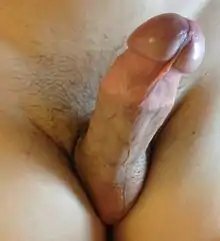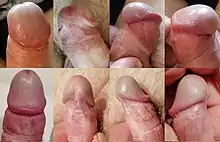Frenulum of prepuce of penis
The frenulum of prepuce of penis, often known simply as the frenulum, is a highly erogenous elastic band of tissue under the glans penis that connects the foreskin to the vernal mucosa, and helps contract the foreskin over the glans.[1] Along with the ridged bands at the tip of the foreskin, it is considered to be the most sensitive part of the penis to fine-touch.[2]
| Frenulum of prepuce | |
|---|---|
 | |
| Details | |
| Identifiers | |
| Latin | Frenulum praeputii |
| TA98 | A09.4.01.012 |
| TA2 | 3676 |
| FMA | 19647 |
| Anatomical terminology | |
In the event of frenulum breve or frenular chordee, or to ensure that the glans can be freely and completely exposed, the frenulum may be partially or totally removed. It is often removed during a circumcision.[3][4][5]
Sensitivity
The frenulum and the associated tissue delta on the underside of the penis below the corona has been described in sexuality textbooks as "very reactive" and "particularly responsive to touch that is light and soft". The "underside of the shaft of the penis, meaning the part below the corona" is a "source of distinct pleasure".[6] Crooks and Baur observe that two extremely sensitive specific locations that many men find particularly responsive to stimulation are the corona, and the frenulum.[7] Repeated stimulation of this structure will cause orgasm and ejaculation in some men.
In men with spinal cord injury preventing sensations from reaching the brain, the frenulum just below the glans can be stimulated to produce orgasm and peri-ejaculatory response.[8][9]
Pathology
Frenulum breve is a condition in which the frenulum is short and restricts the movement of the foreskin, which may or may not interfere with normal sexual activity. The condition can be treated by frenuloplasty, frenectomy, or circumcision. Frenulum breve may contribute to frenular chordee, where the glans is pulled toward the vernal body of the penis. Frenulum breve may also be treated by manually expanding the shaft skin by stretching.
The frenulum may be entirely missing in cases of first degree hypospadias.
It is possible for the frenulum to tear during sexual activities. The frenular artery, a branch of the dorsal artery, may be severed, causing significant bleeding.
Penis frenectomy
A frenectomy can be performed to remove the frenulum from the penis, which is a treatment for frenulum breve or frenular chordee.[10] This is a form of genital frenectomy. The frenulum may be cut when a male is circumcised. This may also reduce the size of the frenular delta. The frenulum was reported to be cut in 26.7%, 20%, and 33.33% of circumcised patients in various surveys.[10][11]
 Frenulum stretched view.
Frenulum stretched view. Frenulum divided by frenuloplasty during circumcision.
Frenulum divided by frenuloplasty during circumcision. Human frenulum preputii penis and frenular delta location
Human frenulum preputii penis and frenular delta location A human frenulum of prepuce of penis displaying frenular chordee.
A human frenulum of prepuce of penis displaying frenular chordee. Part of frenulum unremoved after adult circumcision.
Part of frenulum unremoved after adult circumcision. Excised frenulum after circumcision and radical frenulectomy
Excised frenulum after circumcision and radical frenulectomy Frenulum remnant and scar from a Gomco clamp circumcision of a 34 year old male
Frenulum remnant and scar from a Gomco clamp circumcision of a 34 year old male Penis glans foreskin
Penis glans foreskin Preputial frenulum
Preputial frenulum Healing of Frenuloplasty
Healing of Frenuloplasty Before and after frenoloplasty
Before and after frenoloplasty
References
- Jensen, Christian (2011). Can I Just Ask?. Hay House. p. 58. ISBN 9781848502468.
- Sorrells ML, Snyder JL, Reiss MD, et al. Fine-touch pressure thresholds in the adult penis. BJU Int. 2007;99(4):864–869. doi:10.1111/j.1464-410X.2006.06685.x. PMID 17378847.
- Griffin, AS; Kroovand, R. (1990). "Frenular chordee: implications and treatment". Urology. 35 (2): 133–4. doi:10.1016/0090-4295(90)80060-Z. PMID 2305537.
- Preiser, G; Herschel, M.; Bartman, T.; Andersson, C.; Bailis, S. A.; Shechet, R. J.; Tanenbaum, B.; Kunin, S. A.; Hodges, F. M.; Fleiss, P. M.; Antonopoulos, J.; Rockney, R.; Taylor, A.; Stang, H.; Snellman, L.; Fontaine, P.; Condon, L. M.; Lannon, C. M. (2000). "Circumcision--the debates goes on". Pediatrics. 105 (3 Pt 1): 681–684. doi:10.1542/peds.105.3.681. PMID 10733391.
- "Neonatal Circumcision: An Audiovisual Primer". Stanford School of Medicine. Archived from the original on 2010-06-26. Retrieved 2010-01-25.
- Hass, K.; Hass, A. (1993). Understanding Sexuality. St Louis: Mosby. pp. 99–100. ISBN 0801667488.
- Crooks, R.; Baur, K. (1993). Our Sexuality (5th ed.). Redwood City: Benjamin/Cummings. p. 129. ISBN 0-534-59567-7.
- Saulino, Michael F. (2006). "Rehabilitation of Persons With Spinal Cord Injuries". WebMD.
- Pryor, JL; Leroy, Suzanne C.; Nagel, Theodore C.; Hensleigh, Hugh C. (1995). "Vibratory stimulation for treatment of anejaculation in quadriplegic men". Archives of Physical Medicine and Rehabilitation. 76 (1): 59–64. doi:10.1016/S0003-9993(95)80044-1. PMID 7811177.
- Griffin AS, Kroovand RL (1990). "Frenular chordee: implications and treatment". Urology. 35 (2): 133–4. doi:10.1016/0090-4295(90)80060-Z. PMID 2305537.
- Preiser, Gary (2000). "Circumcision—The Debates Goes On" (PDF). Pediatrics. 105 (3): 681–684. doi:10.1542/peds.105.3.681. PMID 10733391.
External links
| Wikimedia Commons has media related to Frenulum of the human penis. |
- McGrath, Ken (2001). "The Frenular Delta". In Denniston GC; Hodges FM; Milos MF (eds.). Understanding Circumcision: A Multi-Disciplinary Approach to a Multi-Dimensional Problem. New York: Kluwer. ISBN 978-0306467011.